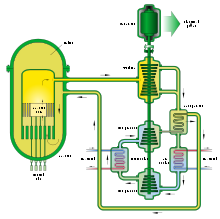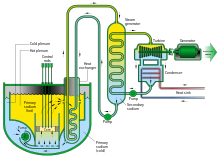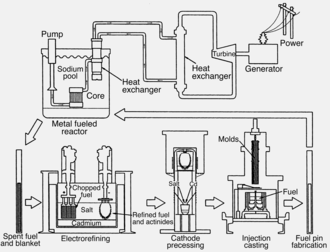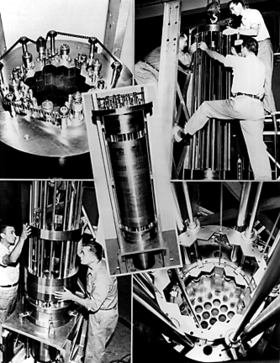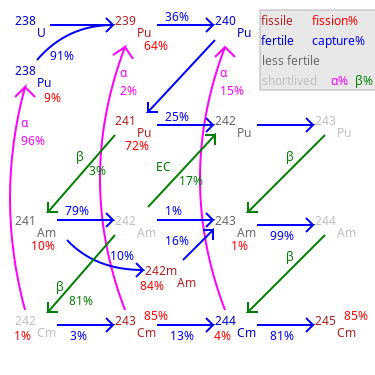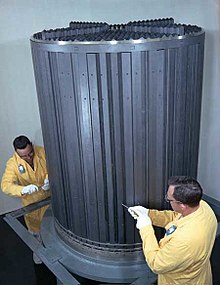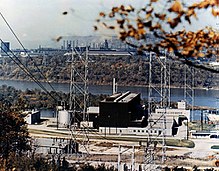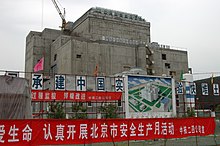Generation IV reactors (Gen IV) are a set of nuclear reactor designs currently being researched for commercial applications by the Generation IV International Forum. They are motivated by a variety of goals including improved safety, sustainability, efficiency, and cost.
The most developed Gen IV reactor design, the sodium fast reactor, has received the greatest share of funding over the years with a number of demonstration facilities operated. The principal Gen IV aspect of the design relates to the development of a sustainable closed fuel cycle for the reactor. The molten-salt reactor, a less developed technology, is considered as potentially having the greatest inherent safety of the six models. The very-high-temperature reactor designs operate at much higher temperatures. This allows for high temperature electrolysis or for sulfur–iodine cycle for the efficient production of hydrogen and the synthesis of carbon-neutral fuels.
According to a timeline compiled by the World Nuclear Association, Gen IV reactors might enter commercial operation between 2020 and 2030. However, as of 2021, no Gen IV projects have advanced significantly beyond the design stage, and several have been abandoned.
Currently the majority of reactors in operation around the world are considered second generation reactor systems, as the vast majority of the first generation systems were retired some time ago, and there are only a few Generation III reactors in operation as of 2021. Generation V reactors refer to reactors that are purely theoretical and are therefore not yet considered feasible in the short term, resulting in limited R&D funding.
History
The Generation IV International Forum (GIF) is "a co-operative international endeavour which was set up to carry out the research and development needed to establish the feasibility and performance capabilities of the next generation nuclear energy systems." It was founded in 2001. Currently, active members of the Generation IV International Forum (GIF) include: Australia, Canada, China, the European Atomic Energy Community (Euratom), France, Japan, Russia, South Africa, South Korea, Switzerland, the United Kingdom and the United States. The non-active members are Argentina and Brazil. Switzerland joined in 2002, Euratom in 2003, China and Russia in 2006, and Australia joined the forum in 2016. The remaining countries were founding members.
The 36th GIF meeting in Brussels was held in November 2013. The Technology Roadmap Update for Generation IV Nuclear Energy Systems was published in January 2014 which details R&D objectives for the next decade. A breakdown of the reactor designs being researched by each forum member has been made available.
In January 2018, it was reported that "the first installation of the pressure vessel cover of the world's first Gen IV reactor" had been completed on the HTR-PM.
Reactor types
Many reactor types were considered initially; however, the list was downsized to focus on the most promising technologies and those that could most likely meet the goals of the Gen IV initiative. Three systems are nominally thermal reactors and four are fast reactors. The Very High Temperature Reactor (VHTR) is also being researched for potentially providing high quality process heat for hydrogen production. The fast reactors offer the possibility of burning actinides to further reduce waste and of being able to "breed more fuel" than they consume. These systems offer significant advances in sustainability, safety and reliability, economics, proliferation resistance (depending on perspective) and physical protection.
Thermal reactors
A thermal reactor is a nuclear reactor that uses slow or thermal neutrons. A neutron moderator is used to slow the neutrons emitted by fission to make them more likely to be captured by the fuel.
Very-high-temperature reactor (VHTR)
The very-high-temperature reactor (VHTR) concept uses a graphite-moderated core with a once-through uranium fuel cycle, using helium or molten salt as a coolant. This reactor design envisions an outlet temperature of 1,000°C. The reactor core can be either a prismatic-block or a pebble bed reactor design. The high temperatures enable applications such as process heat or hydrogen production via the thermochemical sulfur-iodine cycle process.
The planned construction of the first VHTR, the South African pebble bed modular reactor (PBMR), lost government funding in February 2010. A pronounced increase of costs and concerns about possible unexpected technical problems had discouraged potential investors and customers.
The Chinese government began construction of a 200-MW high temperature pebble bed reactor in 2012 as a successor to its HTR-10. Also in 2012, as part of the next generation nuclear plant competition, the Idaho National Laboratory approved a design similar to Areva's prismatic block Antares reactor to be deployed as a prototype by 2021.
X-energy was awarded a five-year $53 million partnership by the United States Department of Energy to advance elements of their reactor development. The Xe-100 is a PBMR that will generate 200-MWt and approximately 76-MWe. The standard Xe-100 four-pack plant generates approximately 300-MWe and will fit on as few as 13 acres. All of the components for the Xe-100 will be road-transportable, and will be installed, rather than constructed, at the project site to streamline construction.
Molten-salt reactor (MSR)
A molten salt reactor is a type of nuclear reactor where the primary coolant, or even the fuel itself is a molten salt mixture. There have been many designs put forward for this type of reactor and a few prototypes built.
The principle of a MSR can be used for thermal, epithermal and fast reactors. Since 2005 the focus has moved towards a fast spectrum MSR (MSFR).
Current concept designs include thermal spectrum reactors (eg IMSR) as well as fast spectrum reactors (eg MCSFR).
The early thermal spectrum concepts and many current ones rely on nuclear fuel, perhaps uranium tetrafluoride (UF4) or thorium tetrafluoride (ThF4), dissolved in molten fluoride salt. The fluid would reach criticality by flowing into a core where graphite would serve as the moderator. Many current concepts rely on fuel that is dispersed in a graphite matrix with the molten salt providing low pressure, high temperature cooling. These Gen IV MSR concepts are often more accurately termed an epithermal reactor than a thermal reactor due to the average speed of the neutrons that would cause the fission events within its fuel being faster than thermal neutrons.
Fast spectrum MSR concept designs (eg MCSFR) do away with the graphite moderator. They achieve criticality by having a sufficient volume of salt with sufficient fissile material. Being fast spectrum they can consume much more of the fuel and leave only short lived waste.
While most MSR designs being pursued are largely derived from the 1960s Molten-Salt Reactor Experiment (MSRE), variants of molten salt technology include the conceptual Dual fluid reactor which is being designed with lead as a cooling medium but molten salt fuel, commonly as the metal chloride e.g. Plutonium(III) chloride, to aid in greater "nuclear waste" closed-fuel cycle capabilities. Other notable approaches differing substantially from MSRE include the Stable Salt Reactor (SSR) concept promoted by MOLTEX, which encases the molten salt in hundreds of the common solid fuel rods that are already well established in the nuclear industry. This latter British design was found to be the most competitive for Small modular reactor development by a British-based consultancy firm Energy Process Development in 2015.
Another design under development is the Molten Chloride Fast Reactor proposed by TerraPower, a U.S.-based nuclear energy and science company. This reactor concept mixes the liquid natural uranium and molten chloride coolant together in the reactor core, reaching very high temperatures while remaining at atmospheric pressure.
Another notable feature of the MSR is the possibility of a thermal spectrum nuclear waste-burner. Conventionally only fast spectrum reactors have been considered viable for utilization or reduction of the spent nuclear stockpiles. The conceptual viability of a thermal waste-burner was first shown in a whitepaper by Seaborg Technologies spring 2015. Thermal waste-burning was achieved by replacing a fraction of the uranium in the spent nuclear fuel with thorium. The net production rate of transuranium element (e.g. plutonium and americium) is reduced below the consumption rate, thus reducing the magnitude of the nuclear storage problem, without the nuclear proliferation concerns and other technical issues associated with a fast reactor.
Supercritical-water-cooled reactor (SCWR)
The supercritical water reactor (SCWR) is a reduced moderation water reactor concept that, due to the average speed of the neutrons that would cause the fission events within the fuel being faster than thermal neutrons, it is more accurately termed an epithermal reactor than a thermal reactor. It uses supercritical water as the working fluid. SCWRs are basically light water reactors (LWR) operating at higher pressure and temperatures with a direct, once-through heat exchange cycle. As most commonly envisioned, it would operate on a direct cycle, much like a boiling water reactor (BWR), but since it uses supercritical water (not to be confused with critical mass) as the working fluid, it would have only one water phase present, which makes the supercritical heat exchange method more similar to a pressurized water reactor (PWR). It could operate at much higher temperatures than both current PWRs and BWRs.
Supercritical water-cooled reactors (SCWRs) are promising advanced nuclear systems because of their high thermal efficiency (i.e., about 45% vs. about 33% efficiency for current LWRs) and considerable plant simplification.
The main mission of the SCWR is generation of low-cost electricity. It is built upon two proven technologies, LWRs, which are the most commonly deployed power generating reactors in the world, and superheated fossil fuel fired boilers, a large number of which are also in use around the world. The SCWR concept is being investigated by 32 organizations in 13 countries.
Because SCWRs are water reactors they share the steam explosion and radioactive steam release hazards of BWRs and LWRs as well as the need for extremely expensive heavy duty pressure vessels, pipes, valves, and pumps. These shared problems are inherently more severe for SCWRs due to operation at higher temperatures.
A SCWR Design under development is the VVER-1700/393 (VVER-SCWR or VVER-SKD) – a Russian Supercritical-water-cooled reactor with double-inlet-core and a breeding ratio of 0.95.
Fast reactors
A fast reactor directly uses the fast neutrons emitted by fission, without moderation. Unlike thermal neutron reactors, fast neutron reactors can be configured to "burn", or fission, all actinides, and given enough time, therefore drastically reduce the actinides fraction in spent nuclear fuel produced by the present world fleet of thermal neutron light water reactors, thus closing the nuclear fuel cycle. Alternatively, if configured differently, they can also breed more actinide fuel than they consume.
Gas-cooled fast reactor (GFR)
The gas-cooled fast reactor (GFR) system features a fast-neutron spectrum and closed fuel cycle for efficient conversion of fertile uranium and management of actinides. The reactor is helium-cooled and with an outlet temperature of 850 °C it is an evolution of the very-high-temperature reactor (VHTR) to a more sustainable fuel cycle. It will use a direct Brayton cycle gas turbine for high thermal efficiency. Several fuel forms are being considered for their potential to operate at very high temperatures and to ensure an excellent retention of fission products: composite ceramic fuel, advanced fuel particles, or ceramic clad elements of actinide compounds. Core configurations are being considered based on pin- or plate-based fuel assemblies or prismatic blocks.
The European Sustainable Nuclear Industrial Initiative is funding three Generation IV reactor systems, one of which is a gas-cooled fast reactor, called Allegro, 100 MW(t), which will be built in a central or eastern European country with construction expected to begin in 2018. The central European Visegrád Group are committed to pursuing the technology. In 2013 German, British, and French institutes finished a 3-year collaboration study on the follow on industrial scale design, known as GoFastR. They were funded by the EU's 7th FWP framework programme, with the goal of making a sustainable VHTR.
Sodium-cooled fast reactor (SFR)
The two largest commercial sodium cooled fast reactors are both in Russia, the BN-600 and the BN-800 (800 MW). The largest ever operated was the Superphenix reactor at over 1200 MW of electrical output, successfully operating for a number of years in France before being decommissioned in 1996. In India, the Fast Breeder Test Reactor (FBTR) reached criticality in October 1985. In September 2002, fuel burn up efficiency in the FBTR for the first time reached the 100,000 megawatt-days per metric ton uranium (MWd/MTU) mark. This is considered an important milestone in Indian breeder reactor technology. Using the experience gained from the operation of the FBTR, the Prototype Fast Breeder Reactor, a 500 MWe Sodium cooled fast reactor is being built at a cost of INR 5,677 crores (~US$900 million). Construction was complete in 2015, but the reactor is not yet critical. The PFBR will be followed by six more Commercial Fast Breeder Reactors (CFBRs) of 600 MWe each.
The Gen IV SFR is a project that builds on two existing projects for sodium cooled FBRs, the oxide fueled fast breeder reactor and the metal fueled integral fast reactor.
The goals are to increase the efficiency of uranium usage by breeding plutonium and eliminating the need for transuranic isotopes ever to leave the site. The reactor design uses an unmoderated core running on fast neutrons, designed to allow any transuranic isotope to be consumed (and in some cases used as fuel). In addition to the benefits of removing the long half-life transuranics from the waste cycle, the SFR fuel expands when the reactor overheats, and the chain reaction automatically slows down. In this manner, it is passively safe.
One SFR reactor concept is cooled by liquid sodium and fueled by a metallic alloy of uranium and plutonium or spent nuclear fuel, the "nuclear waste" of light water reactors. The SFR fuel is contained in steel cladding with liquid sodium filling in the space between the clad elements which make up the fuel assembly. One of the design challenges of an SFR is the risks of handling sodium, which reacts explosively if it comes into contact with water. However, the use of liquid metal instead of water as coolant allows the system to work at atmospheric pressure, reducing the risk of leakage.
The European Sustainable Nuclear Industrial Initiative has funded three Generation IV reactor systems, one of which was a sodium-cooled fast reactor, called ASTRID, Advanced Sodium Technical Reactor for Industrial Demonstration. The ASTRID project was cancelled in August 2019.
Numerous progenitors of the Gen IV SFR exist around the world, with the 400 MWe Fast Flux Test Facility operated successfully for ten years at the Hanford site in Washington State.
The 20 MWe EBR II operated successfully for over thirty years at the Idaho National Laboratory, until it was shut down in 1994.
GE Hitachi's PRISM reactor is a modernized and commercial implementation of the technology developed for the Integral Fast Reactor (IFR), developed by Argonne National Laboratory between 1984 and 1994. The primary purpose of PRISM is burning up spent nuclear fuel from other reactors, rather than breeding new fuel. Presented as an alternative to burying the spent fuel/waste, the design reduces the half lives of the fissionable elements present in spent nuclear fuel while generating electricity largely as a by-product.
Lead-cooled fast reactor (LFR)
The lead-cooled fast reactor features a fast-neutron-spectrum lead or lead/bismuth eutectic (LBE) liquid-metal-cooled reactor with a closed fuel cycle. Options include a range of plant ratings, including a "battery" of 50 to 150 MW of electricity that features a very long refueling interval, a modular system rated at 300 to 400 MW, and a large monolithic plant option at 1,200 MW (The term battery refers to the long-life, factory-fabricated core, not to any provision for electrochemical energy conversion). The fuel is metal or nitride-based containing fertile uranium and transuranics. The reactor is cooled by natural convection with a reactor outlet coolant temperature of 550 °C, possibly ranging up to 800 °C with advanced materials. The higher temperature enables the production of hydrogen by thermochemical processes.
The European Sustainable Nuclear Industrial Initiative is funding three Generation IV reactor systems, one of which is a lead-cooled fast reactor that is also an accelerator-driven sub-critical reactor, called MYRRHA, 100 MW(t), which will be built in Belgium with construction expected to begin after 2014 and the industrial scale version, known as Alfred, slated to be constructed sometime after 2017. A reduced-power model of Myrrha called Guinevere was started up at Mol in March 2009. In 2012 the research team reported that Guinevere was operational.
Two other lead-cooled fast reactors under development are the SVBR-100, a modular 100 MWe lead-bismuth cooled fast neutron reactor concept designed by OKB Gidropress in Russia and the BREST-OD-300 (Lead-cooled fast reactor) 300 MWe, to be developed after the SVBR-100, it will dispense with the fertile blanket around the core and will supersede the sodium cooled BN-600 reactor design, to purportedly give enhanced proliferation resistance. Preparatory construction work commenced in May 2020.
Advantages and disadvantages
Relative to current nuclear power plant technology, the claimed benefits for 4th generation reactors include:
- Nuclear waste that remains radioactive for a few centuries instead of millennia
- 100–300 times more energy yield from the same amount of nuclear fuel
- Broader range of fuels, and even unencapsulated raw fuels (non-pebble MSR, LFTR).
- In some reactors, the ability to consume existing nuclear waste in the production of electricity, that is, a closed nuclear fuel cycle. This strengthens the argument to deem nuclear power as renewable energy.
- Improved operating safety features, such as (depending on design) avoidance of pressurized operation, automatic passive (unpowered, uncommanded) reactor shutdown, avoidance of water cooling and the associated risks of loss of water (leaks or boiling) and hydrogen generation/explosion and contamination of coolant water.
Nuclear reactors do not emit CO2 during operation, although like all low carbon power sources, the mining and construction phase can result in CO2 emissions, if energy sources which are not carbon neutral (such as fossil fuels), or CO2 emitting cements are used during the construction process.
A 2012 Yale University review published in the Journal of Industrial Ecology analyzing CO
2 life cycle assessment (LCA) emissions from nuclear power determined that:
The collective LCA literature indicates that life cycle GHG [greenhouse gas] emissions from nuclear power are only a fraction of traditional fossil sources and comparable to renewable technologies.
Although the paper primarily dealt with data from Generation II reactors, and did not analyze the CO
2 emissions by 2050 of Generation III reactors then under construction, it did summarize the Life Cycle Assessment findings of in development reactor technologies.
FBRs ['Fast Breeder Reactors'] have been evaluated in the LCA literature. The limited literature that evaluates this potential future technology reports median life cycle GHG emissions... similar to or lower than LWRs [Gen II light water reactors] and purports to consume little or no uranium ore.
A specific risk of the sodium-cooled fast reactor is related to using metallic sodium as a coolant. In case of a breach, sodium explosively reacts with water. Fixing breaches may also prove dangerous, as the cheapest noble gas argon is also used to prevent sodium oxidation. Argon, like helium, can displace oxygen in the air and can pose hypoxia concerns, so workers may be exposed to this additional risk. This is a pertinent problem as demonstrated by the events at the loop type Prototype Fast Breeder Reactor Monju at Tsuruga, Japan. Using lead or molten salts mitigates this problem by making the coolant less reactive and allowing a high freezing temperature and low pressure in case of a leak. Disadvantages of lead compared to sodium are much higher viscosity, much higher density, lower heat capacity, and more radioactive neutron activation products.
In many cases, there is already a large amount of experience built up with numerous proof of concept Gen IV designs. For example, the reactors at Fort St. Vrain Generating Station and HTR-10 are similar to the proposed Gen IV VHTR designs, and the pool type EBR-II, Phénix, BN-600 and BN-800 reactor are similar to the proposed pool type Gen IV Sodium Cooled Fast reactors being designed.
Nuclear engineer David Lochbaum cautions that safety risks may be greater initially as reactor operators have little experience with the new design "the problem with new reactors and accidents is twofold: scenarios arise that are impossible to plan for in simulations; and humans make mistakes". As one director of a U.S. research laboratory put it, "fabrication, construction, operation, and maintenance of new reactors will face a steep learning curve: advanced technologies will have a heightened risk of accidents and mistakes. The technology may be proven, but people are not".




